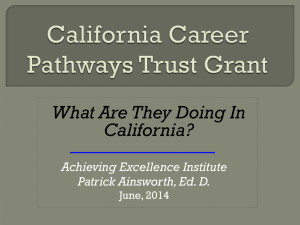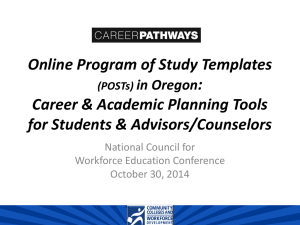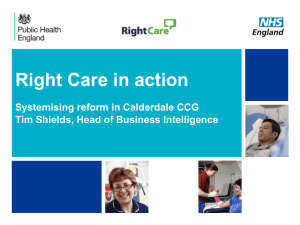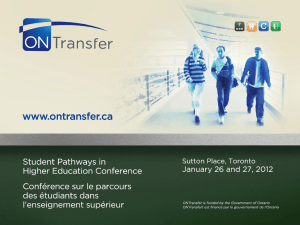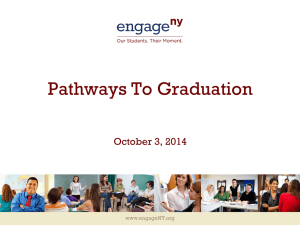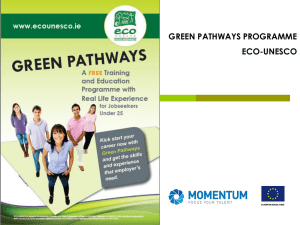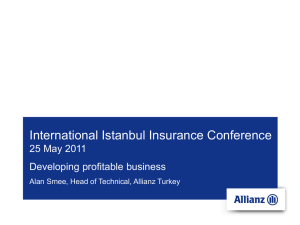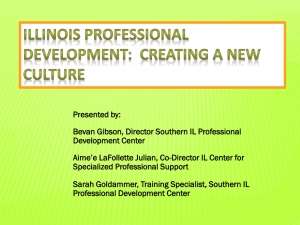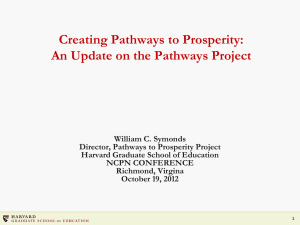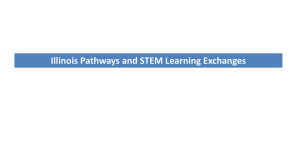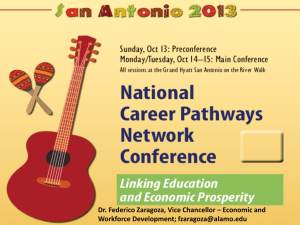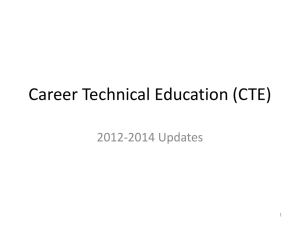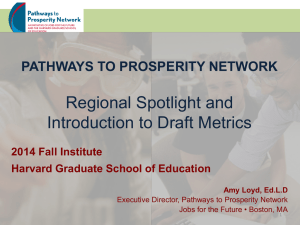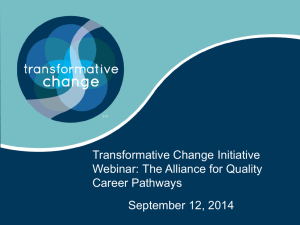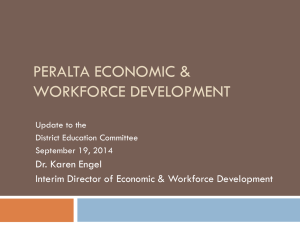Accelerating Opportunity Year One Findings
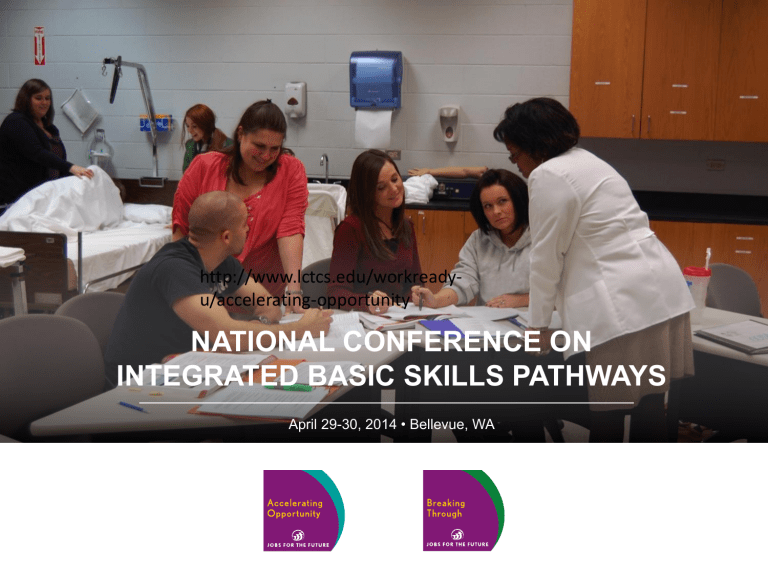
http://www.lctcs.edu/workreadyu/accelerating-opportunity
NATIONAL CONFERENCE ON
INTEGRATED BASIC SKILLS PATHWAYS
April 2930, 2014 • Bellevue, WA
MAJOR PROGRESS MADE IN
FIRST YEAR OF AO
Theresa Anderson & Lauren Eyster
The Urban Institute
April 30, 2014
URBAN INSTITUTE
2
States & Colleges Primarily Focused on
Building AO Pathways during First Year
• Building pathways takes a lot of time & energy
•
Enrollment increased by 3 rd semester
• Almost all colleges developed 2+ pathways in first year
•
Many colleges developed 3+ pathways https://encryptedtbn2.gstatic.com/images?q=tbn:ANd9GcRaEtf_YkEfD40bJHG4dyL
W7o2ZK1c8I5tNCbr4Oc6YzOxjp4Wfjg
URBAN INSTITUTE
3
Pathways Active in Each Semester of the First Year of
Implementation
120
100
80
60
40
20
55 52 101 112
0
Semester
1
Semester
2
Semester
3
Unique
Pathways
For IL, KS, KY, & NC, the first semester was Spring 2012; for LA, the first semester was Fall 2012.
Source: AO College Survey.
URBAN INSTITUTE
4
Many AO Students Expressed Satisfaction with Their Pathway Program
• Positive description of pathways in focus groups
• Many students plan to continue higher education
• Strong “word of mouth” recruitment https://ahc-assets-websitewsp.s3.amazonaws.com/styles/large/s3/pretty%20happy%20women%
20ethnic.jpg?itok=r7egVsmN
URBAN INSTITUTE
5
Institutional Factors Played Important Role in Selection of AO Pathways
• In selecting pathways, colleges considered:
– Labor market demand
– Cooperative CTE departments
– CTE eligibility requirements
– Pathways structures already in place
– Student demand/interest
URBAN INSTITUTE http://timemanagementninja.com/wp-content/uploads/2011/11/Whichpath.jpg
6
Pathways Active in First Year of Implementation, by Industry Area
URBAN INSTITUTE
Source: AO College Survey.
7
Attitudes Toward & Opportunities for Adult
Education Students Beginning to Change
•
Faculty, staff, & students expressed willingness to open doors for adult education students
•
AO students from adult ed. started to identify as college students http://drprem.com/life/wpcontent/uploads/sites/5/2013/07/159301709.jpg
URBAN INSTITUTE
8
Instructors Used Mix of Team Teaching
Approaches for AO Pathways
• 88% of colleges implemented team teaching of some kind
•
Parity between teachers was not always achieved
• Increasing buy-in for
AO & team teaching among CTE faculty & staff is a major priority http://bornstoryteller.files.wordpress.com/2011/05/team_teaching.png
URBAN INSTITUTE
9
Team Teaching Approaches, First Year of
Implementation
Complementary-Supportive 89%
Monitoring Teacher 76%
Traditional 59%
Collaborative 43%
Differentiated Split Class 24%
Parallel Instruction 8%
0% 20% 40% 60% 80% 100%
N=37, Source: AO College Survey
URBAN INSTITUTE
10
Consistent & Comprehensive Network of
Support Services – Still a Work-in-Progress
•
Students had access to academic support services at the college
•
Most AO programs had coordinators, coaches, & navigators
•
Some colleges reached out to partners to provide services
•
Some college staff & students were not aware of services available to students
•
Strengthening support services is an important policy lever for all states
URBAN INSTITUTE http://www.communitypartnersnh.org/wpcontent/themes/nautilius/images/CommunitySupportServices.jpg
11
Selected Support Services Offered to AO Students,
First Year of Implementation
40
35
30
25
20
15
10
5
0
42 18 11 41 16 15 39 12 13 21 7 0 12
3
0
URBAN INSTITUTE
Tutoring or other academic support
College navigation support
Career planning
Transportation
Child care
Source: AO College Survey
12
Loss of Ability to Benefit Caused Major Shift in Most Colleges’ Recruitment Strategies
•
Shifted recruitment towards students with a high school credential & basic skill needs
•
60% of AO students had a high school credential at enrollment
– 21% came from existing CTE programs
• Decreased focus on adult ed. students who may have difficulty ever accessing college http://www.straighterline.com/wp/wpcontent/uploads/image-archive/pell-grants.jpg
URBAN INSTITUTE
13
Recruitment Sources by State,
First Year of Implementation
100%
13%
90%
80%
42%
41%
39%
46%
70%
63%
60%
6%
3%
50%
21% 20%
85%
40%
43%
30%
7%
6%
24%
50%
20%
10%
28%
30%
3%
12%
11%
0%
All
(N=2,588)
IL
(N=419)
KS
(N=1,001)
KY
(N=499)
LA
(N=451)
NC
(N=218)
External
Internal - Other
Internal - CTE
Internal - Dev. Ed.
Internal - Adult Ed.
Source:
AO College Survey
URBAN INSTITUTE
14
Engagement of Workforce Partners
Stronger than Employer Engagement
•
Colleges engaged workforce agencies & local CBOs
•
Some states created state-level partnerships with the workforce system
•
Partnerships with employers were still being formed & strengthened
•
Formed internal partnerships to facilitate the implementation of AO
& gain buy-in http://www.canopy.org/media/advisory-board.jpg
URBAN INSTITUTE
15
Most Common External Partnerships,
First Year of Implementation
Workforce investment system organization
37
Community-based organization 33
Employer 24
Community college district administrative office
22
Other community college 17
Industry association 10
0 10 20 30
Number of Colleges
40
Source: AO College Survey
URBAN INSTITUTE
16
While First-Year Costs Varied, Most
Resources Went to Staffing
•
Resources primarily went toward personnel
•
Costs rose by number of pathways offered & students served
•
State & college staff acknowledged the cost & effort of start-up
•
Expect to realize economies of scale as implementation progresses http://www.mikesroadtrip.com/wpcontent/uploads/2013/09/investment-growth.jpg
URBAN INSTITUTE
17
Components of AO Costs,
First Year of Implementation
Personnel
91%
Courses
3%
Tuition/
Scholarships
Support
Services
Advertising
4% 0.4% 0.9%
Source: AO College Survey.
Consultants
0.1%
Other
0.6%
URBAN INSTITUTE
18
States Supported AO Implementation; Built on Existing Infrastructure & Relationships
•
All states had experience with career pathway initiatives
•
States integrated AO with statewide goals to increase postsecondary degree completion https://www.fhwa.dot.gov/eihd/images/navajo.jpg
URBAN INSTITUTE
19
State Progress on Policy Levers, First Year of
Implementation
IL
KS
KY
LA
NC
Curricular
Alignment
✔
✔
✔
✔
New Funding Models Data Improvement
Performance-based deadline changes
P-20 (existing)
Tiered
Tuition waivers
Merge with Dept. of
Children & Families
P-20 (existing)
Movement into Banner, expansion of P-20
Systemic overhaul
Source: Site visits & program documents .
URBAN INSTITUTE
20
States Engaged in Policy Change; Still
Addressing Challenges
•
Worked toward policy change to support AO sustainability & scalability
•
Challenged by budget constraints
•
Leveraged AO to decision-makers in policy review to improve opportunities for low-skilled adults
•
State offices offered technical assistance, professional development, & AO oversight http://wlsappeals.com/wpcontent/uploads/2012/11/iStock_000017765581Small.jpg
URBAN INSTITUTE
21
State Technical Assistance and Professional
Development, First Year of Implementation
IL
KS
KY
LA
NC
Pathway
Development
✔
✔
✔
✔
Recruitment
/Outreach
Strategies
✔
✔
✔
Professional
Development
Regional
State-wide
State-wide
Labor
Market
Information
✔
✔
✔
State-wide
& regional
✔
✔ In progress
Source: Site visits & program documents.
Surveys on
College AO
Needs
✔
✔
✔
(2)
URBAN INSTITUTE
22
KY
LA
NC
ALL
IL
KS
The Year in Review…
Credentials
Awarded
2,641
581
1,190
449
369
52
Credits Awarded
13,382.5
4,221
4,802.5
2,063
1,629
667
Source: AO College Survey.
Students Enrolled
2,588
419
1,001
499
451
218
URBAN INSTITUTE
23
Next Steps in the Evaluation
May 2014
1 st Year
Implementation Report
Late 2014
2 nd Year
Implementation Report
URBAN INSTITUTE
Late 2014
Year 3 College
Survey
Late 2014/
Early 2015
Report on Early
Impact Findings
2016
Final Reports
24
Questions?
Theresa Anderson
AO Evaluation Project Manager
The Urban Institute tanderson@urban.org
Lauren Eyster
AO Evaluation Project Director
The Urban Institute leyster@urban.org
URBAN INSTITUTE
25
NATIONAL CONFERENCE ON
INTEGRATED BASIC SKILLS PATHWAYS
April 2930, 2014 • Bellevue, WA
New Funding for AO-K
From the Department for Children and Families:
Up to $1.7million during FY 14
From Legislature:
$500,000 for use in AO-K Programs (Proviso to SB155)
$1,900,000 GED Accelerator (incentive for
GEDs and CTE certificate)
Scaling Accelerating
Opportunity in IL
Transitions Academy
An intensive one year project
Application process
Funded by Adult Education and
Career and Technical Education
Face to face meetings, online courses, webinars, assignments, transitions blog, google group, mentors assigned, and a final presentation
Two-day Workshop
Day one is for the academy participants
Day two is open to the entire state
Expansion to 18 colleges
FY2015 adding 4-6 colleges
Louisiana’s New Attitude
• 4 th Anniversary of WorkReady U in July
• Comprehensive Approach to Adult Ed.
• Focus on the Undereducated and
Underemployed
• AE Scaled from 1 College to ALL 13
• Adult Learner Stereotypes Shattered
• Partnership Network Aligned
• Biggest AO Skeptics Embraced & Utilized
• AO Scaled from 9 Colleges to ALL 13
Scaling & Sustaining
AOKY is Statewide!
Recruitment is Everybody ’ s Business
Team Teaching is an Equal Partnership
Next Frontier: AOKY 2.0
A-OK 2012-
2014
Communicating the Success
Transition Newsletter
Highlights a program
Events
Presentations:
Board Meetings
Community College Presidents
Council
Community College Trustees
Association
Community College Faculty
Chief Academic Officers
CTE/Perkins
P-20 Council
IL Longitudinal Data System
Committee
Adult Education Program
Directors
AO Report - Compendium
IL AO Video
Black Hawk College- 1 st AO Cohort
Illinois Community College Board Meeting
The Opportunity to be Part of the
Solution
Louisiana’s Economic and Moral Imperative
• 1 in 5 working aged citizens do NOT possess a HSE
• The Skills Gap is widening – PIACC Report
• Federal Financial Aid Guidelines – Barrier to Success
• LA workforce needs are exploding
LWC projected increase of demand for workers =
236,000 through 2020
LWC projected more than 621,000 new job opening through 2020
• Postsecondary Education in LA is changing – Wise Funding
Using Data to Demonstrate Success
Comparison of AO students & first time students: Spring 2012- Fall 2013
AO Students Comparison Group
Number
1,343
Percent Number
10,743
Percent
Students Enrolled
Number of students who earned a KCTCS credential(s)
684 50.9% 923 8.59%
Number of credentials earned by students
Licenses and industry recognized credentials earned
Number of students who enrolled in subsequent term
863
177
978 72.82%
1,827
230
7,405 68.93%
NATIONAL CONFERENCE ON
INTEGRATED BASIC SKILLS PATHWAYS
April 2930, 2014 • Bellevue, WA
